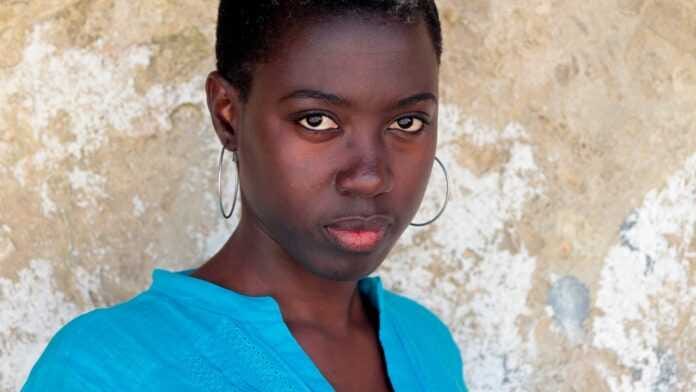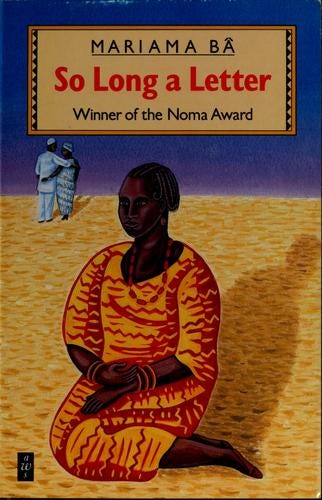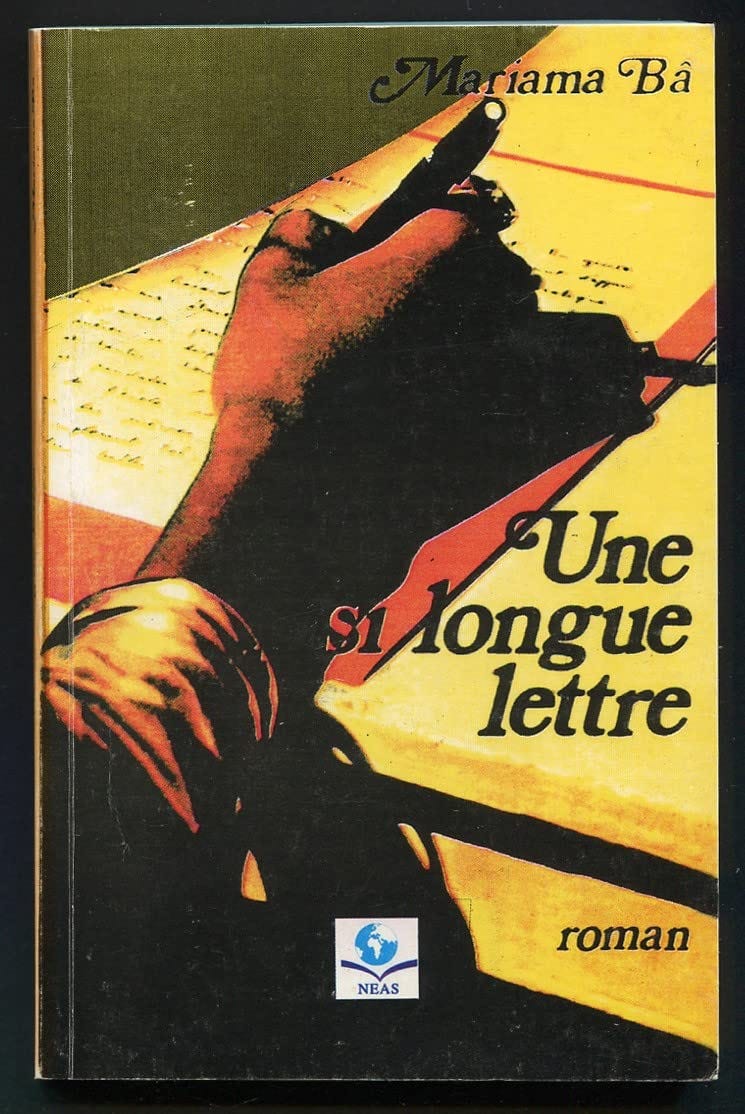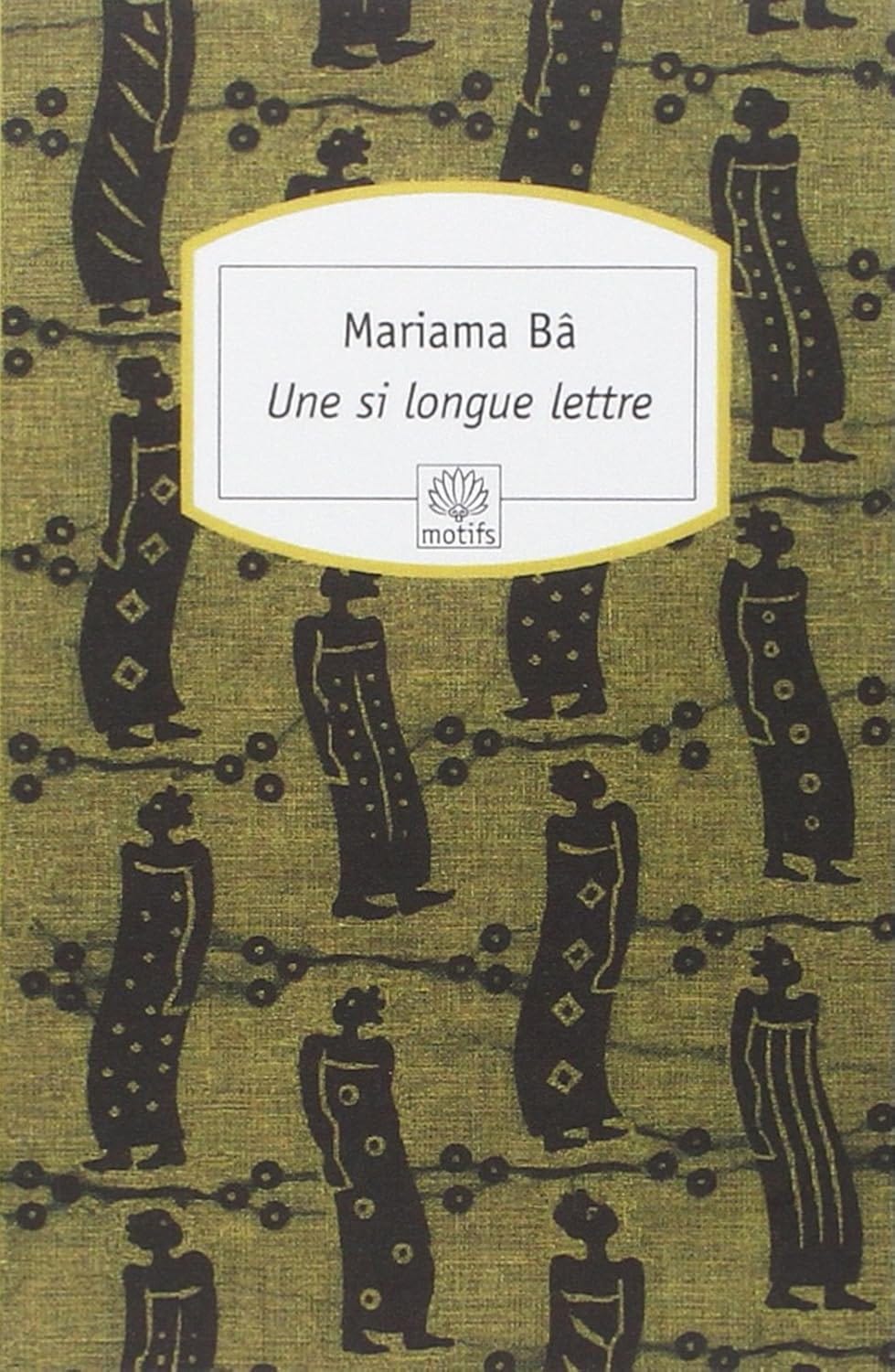Later today, 4 July 2025, Angèle Diabang’s feature-film adaptation of Mariama Bâ’s 1979 novel Une si longue lettre will have its broad opening after more than a decade of her tireless work, and a debut at FESPACO in Ouagadougou earlier this year. Billboards for it have been visible along Dakar’s West Coast Road, which Bâ’s heroine Ramatoulaye would take from her home for weekends on beaches that were in the mid-twentieth century well outside the city, on the far side of the plains of Ouakam: Ngor, Almadies, Yoff.1 All of these places are currently part of metropolitan Dakar. Bâ never names Ramatoulaye’s neighborhood, though she situates it farther from the coast, more urbanized and modest than Fann; nicer and more recently constructed than her in-laws’ places; farther from the SICAPs than is Fann; and just south of Ouakam. The economic distinction between her neighborhood and Fann is that Fann can be afforded on the earnings of an unmarried doctor in private practice, and hers on that of the unmarried civil servant that her husband had been before their marriage. I read her as living in Mermoz above Sacre-Cœur but perhaps as far south as Point E, where Bâ had lived before becoming a writer.2
One of the things that excites me about promotional photography from the film is that it leans into something quite obvious in Bâ’s novel, but often absent from discussions of it: that it takes place among the social, intellectual, and economic elite of independence-era Senegal.
The cover version.
The first time I read the book was in English translation: Mariama Bâ’s So Long A Letter was published by Heinemann’s African Writers Series; for years it was printed with a dour cover that might fit better with something by J. M. Coetzee: a forlorn woman sits on the ground in the middle of a vast desert, as, in the distance, a man walks openly with waist encircled by the arm of another woman. None of them are dressed in such a way as to give the viewer much sense of their social status.3
In her introduction to Ann Petry’s The Street, Tayari Jones talks about how that beloved American novel went through scores of editions. She discusses how the covers of those editions, when placed side-by-side, come across as so many “ironic images” that both mask and reveal the book’s content.4 The same is certainly true for Une si longue lettre. When published by Nouvelles Éditions Africaines Sénégal, the book was printed with a series of covers showing elegant hands, manicured and bejewelled, writing with pens.5 Over time, the visual class-markers became less prominent until they flipped: the cover of a late edition shows a young, sad woman in an inexpensive veil, holding a pen without writing.6 The edition I currently own, from Le Rocher, features on its cover a cloth with a repeating motif of six individual women with uncovered heads with wrap skirts secured around their chests—a style that in Senegal is usually reserved for immediately after a bath and before dressing, a period of the day that does not much figure in Bâ’s novel.
The back cover copy of the Rocher edition concludes in broad strokes: “The Senegalese Mariama Bâ is the first African novelist to describe with such clarity the place reserved for women in her society.”7
The book itself, especially in its last pages, does contains such statements as:
“I have finally decided to face the issues of sexual education.”8
“My heart rejoices every time a woman emerges from the shadows.”9
“The success of a nation passes without fail through the family.”10
It might all seem, from a distance, a little unapproachably perfect; almost too good, too homiletic, and too inarguable. But Bâ earns these sentences across 165 short pages that are very much not sermonizing. The book’s unflagging success for the last half-century very much testifies to that.
Still, there is a problem with Une si longue lettre. It is not a problem in the book; it is not a problem with Bâ; it is not a problem with the generations of readers who have read and loved Ramatoulaye, Aïssatou, and their children. It is a problem with how the novel has been presented, one that has, ironically, played its own small role in holding back literature by African women.11
Celebrating the bad and the killjoys.
In 2014, Roxane Gay published the essay collection Bad Feminist. It was a delightfully liberatory moment, conceptually speaking. Gay, of course, is not a bad feminist in any perverse sense. She is imperfect, however: she is human. She is both more than a feminist and less than one. She sometimes does not live up to her ideals, and is sometimes confused or even irritated by them. She can disagree with other feminists, and with particular feminisms. Her feminism guides her, very often. It does not corset her. It is not an impossible and ponderous standard that she must port everywhere and never set down, a Sisyphus under the weight of perfection.
while struggling with the balance between her and her friends’ private liberalism and their public radicalism, Mariama Bâ dreamed up the elegant Ramatoulaye and her sangfroid.
Nine years later, Sara Ahmed published The Feminist Killjoy Handbook. If Gay can inspire unrepressed excitement in an imperfect yet committed rejection of what keeps women back, and a striving for a better world, Ahmed opens up exciting vistas for occasionally cranky, unpleasant, uncompromising approaches to feminism.
Gay and Ahmed’s projects are importantly contiguous, a point that they both happily acknowledge.12 They deny any extent to which feminism might be considered the conceptual equivalent of shredded wheat: bland; dour; and uniform. Yet the counterproductive pressure for literature to be a series of plain, one-size-fits-all “good feminist” texts persists.
The personal and the political.
Bâ seems to have seen herself a bad feminist, in Gay’s great free sense of the term. After being diagnosed with cancer, Bâ reproached herself for having a greater appreciation for clothes than for charity, thus not giving enough to the poor.13 The conflict between Bâ’s materialist predilections and the redistributionist values she shared with each of her three politically radical husbands were the cause of many disputes with her third husband,14 from whom she separated for other reasons, but to whom she remained married until her death in 1981.15
In exhibiting a tension between staunchly middle-class and individualist practice and radical philosophy, Bâ was exemplary of the Senegal in the third quarter of the twentieth century. The ruling party had in the 1940s split off from the French section of the Workers’ International, rebranded twice, and rejoined the Socialist International in 1976. Nominally, it was a centrist social democratic party that never once wavered in its policy alignment with France and the United States. Bâ was perhaps a typical politically active francophone West African in deeply admiring Guinea-Conakry’s Sekou Touré for his political convictions while disapproving vehemently of his authoritarianism.16 Her open sympathy for the opposition Democratic Party of Senegal, or PDS, after political pluralism was formally legalized in 1974 was due in part to the relatively greater opportunities the PDS offered to female politicians than did the ruling party. Too-great an attachment to any one party was not to Bâ’s taste, and when in 1981 the ruling party, by then called the Socialists, came under the sway of the exquisitely suave and handsome Abdou Diouf, who early in his term advocated pro-feminist policies to a then-unprecedented extent, her attachment to the government party, which had never fully extinguished, was renewed.17
In the 1970s, Bâ’s eldest children got married, her middle children helped with the raising of the youngest, and even living separated from her husband, she could afford to keep up a cadre of domestic staff. At the same time, the extreme political stresses of the period from 1962 – ’68 had largely abated. It was in these years that Bâ’s social and parapolitical activity peaked; She played major roles in organizations founded by alumna of the teaching school she had attended in the 1940s. In the words of Mame Coumba Ndiaye:
Toward the beginning of the ’70s, Dakar and the big cities bloomed with associations, social justice organizations (NGOs not yet being in style), and clubs with a feminist tone. It was as if the majority of the feminine elite had understood, in these years of total disenchantment, that their salvation lay in women’s militancy transcending political divisions and rivalries.18
Bâ came to lead several such organizations, and Ndiaye publishes several of her speeches from this period. One of the most paradoxically exciting thing about such addresses, such as her valedictory to the Dakar Soroptimist Club, is the extent to which she does not demonstrate the serenity and inspirational spark of Ramatoulaye. Instead, she harangues her longtime friends and colleagues for not showing up enough to meetings, for having misaligned priorities, for displaying, as a group, what she calls “fixed and hostile behavior.”19 Here, Bâ does not inspire; she does not forget, and rarely forgives; she is cranky and often not at all up for games; she doesn’t find it funny; she is a gloriously sharp-tongued killjoy.
It seems to be that precisely while suffering the slings and arrows of a life of increasing activism, while struggling with the balance between her and her friends’ private liberalism and their public radicalism, Mariama Bâ dreamed up the elegant Ramatoulaye and her sangfroid.20 Ramatoulaye, like Bâ, came from a milieu of weekends at the beach, gifts of cars between friends;21 courtships that saw young women with then-rare secondary educations choosing between some suitors who were now rich, others who were peers in young age and middle grade, and others who would one day be government ministers; of men underwriting not just their own pilgrimages to Mecca but separate ones for their wives and in-laws. It was a precarious class, sometimes underwritten by debts so staggering as to hasten not just a borrower’s demise, but his death.22 It was a milieu made up of the highest caste of a small number of the country’s three-score ethnicities; while these ethnicities often intermarried,23 a mixed-caste marriage was almost unthinkable.24
As mentioned earlier, Ramatoulaye, the heroine and narrator of Une si longue lettre, works herself up to a series of feminist conclusions of impressive sympathy and sweep. But on the path there, her story has a particularity. It is particular in how her gender intersects with her class, her caste, her education, and her tastes. These are things that get glossed over in calling the book that weaves around her as broadly being about “the place reserved for women in her society.”
Four authors who would not be the next Mariama Bâ.
Kangi Alem writes of the Togolese author Gad Ami in 1986 in his preface to a recent reissue of her debut novel Étrange heritage, “In that decade, next to a Gisèle Hountondji or a Tchotcho Ekué, hers was among the names that were put forward to pick up from where the Senegalese Mariama Bâ, who had passed away five years earlier, had left off.”25 Like Ramatoulaye, Déla, Ami’s narrator, is far more sinned against than sinning. Ami admirably situates Déla in a very specific context that gets her narrative off to a quick start and keeps things moving ever-more briskly along.26 Yet, like Hountondji and Ekué, Ami never became the next Mariama Bâ.
Nor did the quicksilver Senegalese author Ken Bugul, whose debut novel Le baobab fou prompted excited comparisons to Bâ upon its apparition in 1983.27 Bugul’s case is particularly distressing, because Le baobab fou, while a promising first work featuring an only marginally less tragic heroine than would Étrange heritage three years later, is by a long shot not even as good a novel as the one that set Bugul’s career back fifteen years. That would be Riwan, ou le chemin de sable, whose heroine, rather than being faultless on the first page and heavily encumbered on the last, is an erudite and broadly experienced woman who freely chooses for herself to be a man’s twenty-eighth spouse, a choice she does not come to regret by the end of the book.28
A fifth author who would not be the next Mariama Bâ.
Mariama Bâ passed away from cancer in 1981, before her second novel could be published. Nonetheless, while Un chant écarlate secured translations into several languages even before its first French edition was published, an exceedingly rare turn of events in for a book by a female African author in the twentieth century, its success had a short half-life. Mame Coumba Ndiaye suspects that part of the book’s problem may have been that it depicted a mixed-race couple in which the heroine, Mireille, is white. As in Une si longue lettre, female characters are largely sympathetic and male characters unsympathetic.29 Yet the racial issue muddies matters. If we assume that a novel is supposed to make us root for one person and against another, what are we supposed to do with a novel set in the immediate post-independence era by a black author whose most central black characters are unsympathetic, and whose most central white character is sympathetic? That distribution of character traits makes it hard to treat the novel as a sporting event at which the reader is confident in knowing exactly when and for whom to cheer.
I would argue that Bâ’s longstanding reputation as one of the most-good feminist authors of the Atlantic world is in no small part due to the fact that she died so soon after Une si longue lettre was first published. Her absence from the scene made it easier to flatten her into someone whose story could be blown free of the specificity of Ramatoulaye as a highly educated urban African woman from an established family; of Ramatoulaye as someone and who travelled a hard and uncertain path to her expressed commitment to gender equality for all. So flattened, Bâ’s book could be breezed off into a story of that commitment for generalized equality. But the flattening of Une si longue lettre is a fileting of what it actually is.
Can a feminist excusably write a book with fundamentally imperfect characters? Can she put them in a universe whose moral arc she does not follow all the way through to justice? Can she end on tonal discord and misdirection? Can she leave certain fundamental questions fundamentally unanswered? Can she be suffered to make a mistake?
Had Bâ lived longer, she might have posed more of a challenge. She might well have not exactly matched what in the 1980s was crystallized as the Bâ-tagged standard for African feminist novels. After all, according to Ndiaye, Bâ’s third book, which has never made it past the manuscript stage, would have been yet harder to lightly scan: it had unsympathetic central female characters.30
The challenge of difficult women as characters.
Seraph on the Suwanee was Zora Neale Hurston’s last published novel. Unlike Hurston’s earlier books, it featured, like Bâ’s Un chant écarlate would after it, a white heroine. Hurston’s characters were always complex and hard to get a bead on, and Arvay Henson was no different in that regard: she was a white woman who, as a teenager, had been a victim of rape and then married Jim Meserve, her rapist, who “thought her a trifle dumb.”31 The mere desire to be with Arvay inspires men to heights they otherwise would never try to reach, and yet she lives her own best life only when she lets Jim have his way.32 What may be most challenging in a very challenging book is a trend of behavior that repeats itself exactly in what is positioned to be the resolution to the book’s climax: Hurston suggests Arvay repeatedly chooses situations where she might expect to be party to sex to which she could not meaningfully consent.33 There is no finger-snappingly easy way to fit this book’s own words out as a feminist interpretation of its own plot. In her introduction to Seraph, Hazel Carby addresses this challenge head-on:
Readers of [Hurston’s] Their Eyes Were Watching God will be reminded of the pompous second husband of Janie, Jody Starks, who asserted that “Somebody got to think for women and chillun and cows,” because they couldn’t think for themselves.[] The difficulty for a feminist reading of Seraph on the Suwanee is that Jim Meserve, unlike Jody Starks, does not conveniently die so that his wife can get on with her life.34
Carby’s point echoes a sentence in Alice Walker’s essay “Writing The Color Purple”: “Fortunately, I was able to bring Celie’s own children back to her (a unique power of novelists), though it took thirty years and a good bit of foreign travel.”35 Can a feminist, be she good or Gay-esque bad, excusably write a book with fundamentally imperfect characters? Can she put them in a universe whose moral arc she does not follow all the way through to justice? Can she end on tonal discord and misdirection? Can she leave certain fundamental questions fundamentally unanswered? Can she be suffered to make a mistake?
The burden of carrying perfection.
Since the 1990s century, feminist criticism—not anywhere near all of it, obviously, it’s a big field—has often asked of novels and stories whether they are “feminist texts.” It is a bit of an unfair question, asking the thing that critics and academics are studying (“texts”) to do part of the critics’ and academics’ own work: produce feminist analysis. This trend was not born in the 1990s, but rather grew slowly over time since Kate Millet’s Sexual Politics, which in 1970 compared D. H. Lawrence, Henry Miller, Norman Mailer, and Jean Genet, preferring one over the others for the specific reason of their treatment of women.
It is fair to criticize books for their unrealistic or exploitative depictions of women. It is also hard to draw a line between that fair practice and the unfair and stifling practice of asking individual works of fiction to be in and of themselves clear, comfortable, and acceptable expressions of feminist doctrine. Such does not seem to have been Millett’s project: according to the standards of 1970s feminism, she was herself a bad feminist; she was a feminist killjoy. It is only in retrospect that Millett’s ideas have gotten their full measure of appreciation.
With as mightily as Millett struggled to keep herself and her career moving forward, the oppressive weight of asking books by women to live up to a particular standard can weigh just as heavily if not more on authors from black geographies.
After Seraph on the Suwanee, Hurston never was never able to get another novel published in her lifetime. When she died, she was buried in an unmarked grave.36
Gad Ami’s body of work is now undergoing a reconsideration, though at the level of placing her in the total history of Togolese fiction; nearly thirty years passed between the publications of her first and second novels. Ken Bugul and Aminata Sow Fall are rightly celebrated as two of the greatest living Senegalese novelists, though to this day, it is harder to find a given title by Bugul in Dakar bookstores than it is to find the works of the Cameroonian Leonora Miano, to whom Bugul is not inferior.
Those of you who speak only English cannot read a single one of Bugul’s five best novels.37 And this gets to the three walls that stand between so many female writers from black geographies and anglophone readers. First is the Room of One’s Own wall that stands between contemporary women and having time and space to write at all. Then comes the wall that stands between women writers everywhere and finding a publisher. Third is the wall that stands between published writers and opportunities to be translated.
You made a fool of death with your beauty.
So what are readers and critics to do? First, let us not make of Mariama Bâ, or anyone else, a universal standard of feminist expression to which other writers must aspire. Bâ wrote about a particular milieu very well. It is, in a different country, much the same milieu that Terry McMillan wrote about in Waiting to Exhale and How Stella Got Her Groove Back. The early history of this class in the United States was the subject of the life’s work of the historian Carter Woodson, while the sociologist Franklin Frazier offered a controversial take about the same set on the eve of the Civil Rights movement in his Black Bourgeoisie. Gail Lumet Buckley gave Woodson and Frazier’s subject the autobiographical treatment in The Hornes, tracing one black family’s spectacular rise and then seeming disappearance just one generation after its apotheosis. In 1988, René Depestre took readers on a giddy tour of this class in Hadriana dans tous mes rêves; no English translation appeared until 2017. Back on the American side of things, Nell Scovell and Sheryl Sandberg took a very non-intersectional take on aspirational white women of the same social class in 2013’s Lean In.38 After significant criticism that was temporally correlated with personal tragedy, Sandberg co-wrote Option B, which walked back some of Lean In’s most strongly worded claims.

Mariama Bâ may have found the nearest literary heir to her debut novel not among francophone authors, but in Nigeria. The beginning of Chimamanda Ngozi Adichie’s Half of a Yellow Sun aggressively questions the early modern French assertion that no man is a hero to his valet; the same book’s ending squarely refutes the corollary offered in a lecture by G. W. F. Hegel that this is because a valet cannot transcend his servile status. Adichie’s Professor Odenigbo is a hero to his houseboy Ugwu for slightly longer than he might seem heroic to a stranger. After his disenchantment, Ugwu struggles to reach a mature understanding of Odenigbo until after Odenigbo’s university closes due to the Biafra war, and after Ugwu supplants a broken Odenigbo as the novel’s central writer and thinker. Through her fiction and essays before and after Sun, Adichie has offered gorgeously limpid prose examining several decades of extensive but not exhaustive potentials and pitfalls surrounding the relationship between feminism and the concept of noblesse oblige.
Just a year before the 2006 appearance of Adichie’s Sun, Taiye Selasi came in for an unfair share of opprobrium for her essay “Bye-Bye Barbar,” which gave a name to the transcontinental social class about which Bâ, Adichie, and scores of other African and diaspora authors wrote: Afropolitans. Selasi’s censure was made possible by the same trends which put bareheaded Bantu knots and inexpensive headscarves on the cover of various editions of Une Si Longue Lettre: a preference to shoehorn any discussion of Africa into a classless model of the continent in which as many characters as possible are assumed by default to live on a stream of income significantly below the global median.
What we should think about wealth and poverty in the world is one thing; discouraging honest discussions and depictions of either of them is quite another. Just as Roxane Gay has shown that there are a lot of great ways to be a “bad feminist,” there are also a lot of different ways to experience wealth, chosen or forced moderation, and poverty. Writers should write about them, diversely.

As time has gone on, fictional and factual depictions of global Afropolitans have diversified. In 2023, Taiye Selasi’s celebration of Kehinde Fadipe’s The Sun Sets in Singapore topped that book’s jacket of advance praise.39 Just two years earlier, Akwaeke Emezi’s memoir Dear Senthuran took the form of a series of seemingly hermetic letters, each addressed to a different person. It all climaxed in a chapter called “Opulence | Dear Kathleen” in which Emezi writes, “I’ve started fitting into Shiny, the godhouse, with all its gold and velvet”40 before twirling the whole fractiousness of the preceding book into a neat paragraph of unanticipated unity:
I am growing lemon balm out back for Katherine; she likes to use it for tea. I’m saving chocolate habaneros in the garden so you and I can make syrups when you arrive. There are haw flakes in the pantry for my sister, a pretty blue bowl on the kitchen counter for Alex to put their rings in when they wash their hands, and I got some new yellow place mats for when we do our little dinners again. Ann and I are going to make akara from scratch, Marguerite will teach me that shadowbeni recipe I’m obsessed with, and I have a signed first edition of Toni Morrison’s Jazz to surprise Tiona with when she gets here. The richness I want is the kind that can be shared, where we are all together and alive.
Isn’t it wonderful?41
Later today Angèle Diabang’s movie adaptation of Une si longue lettre will debut. It looks to crackle with excitement, disappointment, loss, possibility, and potential. I expect it to be beautiful, challenging, memorious, and unique. It probably won’t be exactly the film you or I might individually hope to see. I don’t expect it to kill anyone’s joy, though if it does, that might just mean it is doing something right. I expect it to be very rightly bad, in all the best ways.
(Bâ 1979/2005, p. 47).
(Ndiaye 2007, p. 145). At the earliest time comprehended by Bâ’s novel, a boom in low-priced real estate in Ouakam had been under way for perhaps less than a decade, and the plain was being built over by businesses, the government, and an aspirational lower middle class, or at least landlords to such a class (see, eg. Le Goff as quoted in Barthélémy 2010, p. 157; Bâ 1979/2005, p. 23).
The cover of a more recent Waveland Press edition features a stylized bird’s wing in the colors of the Senegalese flag over a black background, with a promotional quote attributed to “West Africa.”
(Jones in Petry 1946/2020, pp. ixf)
One of these covers has also been used by Heinemann.
In the novel’s narrative present, Ramatoulaye is a widow whose eldest daughter’s best friend got married four years prior.
(in Bâ 1979/2005, np; my translation)
(Bâ 1979/2005, p. 160; my translation)
(Bâ 1979/2005, p. 163; my translation)
(Bâ 1979/2005, p. 164; my translation)
To be clear, I am not arguing that the problem discussed in this essay is one of the primary obstacles to the flourishing of such literature. But it is an obstacle nonetheless.
Each has a Substack; Ahmed’s is called Feminist Killjoys.
Gay’s is called The Audacity.
Run, don’t walk, and all the other encouragement to anyone not as yet reading them.
(Ndiaye 2007, p. 91)
(Ndiaye 2007, p. 139)
No full biography of Bâ has ever been published. Mariama Bâ, ou les allées d’un destin, the memoir of her daughter Mame Coumba Ndiaye, comes closest to filling that role, and is the source for most biographical claims here.
(Ndiaye 2007, p. 56)
(Ndiaye 2007, pp. 59f)
(Ndiaye 2007, p. 119)
(Bâ in Ndiaye 2007, p. 192)
Bâ’s cultural context is best triangulated between Keïta 1975/2014, Ndiaye 2007, and Barthélémy 2010, the last of which draws on the first two, other published texts, and semi-structured interviews.
(Bâ 1979/2005, p. 102)
(Sembène 1973/2020, p.190; Fall 1976/2021, pp. 129, 149; Bâ 1979/2005, pp. 27-29)
Ndiaye identifies Bâ’s father, late colonial-era politician Amadou Bâ, as Soninke of the Senegalese diaspora of Massina in Mali. She circuitously describes connections to the nobility of Kajoor for Bâ’s maternal line (Ndiaye 2007, pp. 16-19). The surname “Bâ” itself suggests a Fulani connection.
(Bâ 1979/2005, pp. 56, 59; Ndiaye 2007, p. 151)
(Alem in Ami 1986/2022, p. 7)
More so than Une si longue lettre, Étrange heritage relies for its strength on the direction of its plot. And so while the precise outlines might not be hard to predict, readers would be best off saving Alem’s preface for the end.
In the 1990s, Bugul would help introduce Koyo Kouoh, a budding Swiss-Cameroonian curator, to the art scene in Dakar. Kouoh’s subsequent meeting with the male artist Issa Samb would play a greater role in the story of Kouoh’s career as later retold; Bugul and Kouoh would remain friends until Kouoh’s death from cancer in 2025. For a discussion of Kouoh published here at the Radical Cape Reading Room, see:
I would say that Riwan’s sentences are musically faultless had I not also had the pleasure of reading Bugul’s De l’autre côté du regard, the lines of which Bugul lightly and achingly wove in extension of its epigraph, the Senegalese lullaby “Ayo nenne.” Like Riwan and the bulk of Bugul’s work, De l’autre côté du regard has never been translated into English.
In both books, unsympathetic mothers-in-law are the exception that proves the rule. Chant’s Yaye Khady, whom the reader meets even before Mireille (Bâ 1981/2020, pp. 11, 34) plays a larger role in her book than do her homologues in Une si longue lettre.
(Ndiaye 2007, p. 114 footnote)
(Hurston 1948/1991, p. 66)
(Hurston 1948/1991, pp. 295, 298)
(Hurston 1948/1991, pp. 347-349)
(Carby in Hurston 1948/1991, p. xv)
(Walker 1983, p. 359)
(Walker 1983, p. 93) Notably, Alice Walker, the first contemporary Hurston enthusiast, wrote that Seraph was “about white people for whom it is impossible to care, which is [a crime]” (Walker 1983, p. 90). I don’t find the mostly poor white characters of Seraph any harder to care for than the mostly rich white characters of Otessa Moshfegh’s fiction, but my tastes are catholic and the more fundamental point is: opinions about how to react to Seraph, as those about how to feel about many books, can and certainly do vary. Walker would doubtless agree that such variance does not justify the neglected potter’s field into which the memory of Hurston was cast, first during her life, and then for a decade after her death.
The privileging of anglophone audiences in this analysis is due to two points. First, that the global community that reads English as a first or second language is larger than that for any other single language, and second, that the economic heft of the anglophone publishing industry is greater than that for any other language. Because of these facts, translation into English is often but not always a leading indicator for general availability outside of the first language in which a book was written. Still, for a discussion of common cognitive bias relating to the length of the long tail of the global curve language-community populations, see:
Will AI save endangered languages?
Over at the Brookings Institute’s Tech Tank, Brooke Tanner and Cameron Kerry ask “Can small language models revitalize indigenous languages?” They begin with a discussion of what Small Language Models, or SLMs are; they are like the more well-known Large Language Models—LLMs—of which OpenAI’s ChatGPT may be the most famous, but they require fewer resour…
Scovell is a writer of scripts for popular television series; Sandberg is a corporate executive. The literature review around which their book’s claims were structured was performed by sociologist Marianne Cooper (Sandberg and Scovell 2013, pp. 142, 175f).
I personally struggled with Fadipe’s Sun, but as with Hurston’s Seraph, that goes more to show that there are many different ways of reacting to books than it does to say anything in particular about the book in question.
(Emezi 2021, pp. 218f)
(Emezi 2021, pp. 222f)











